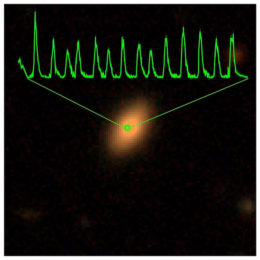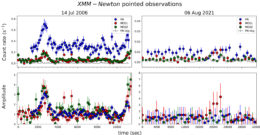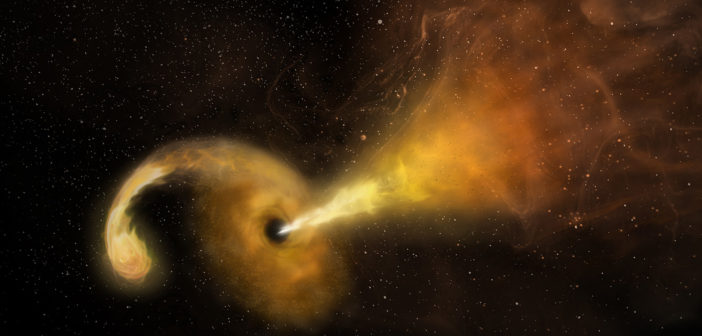Astronomers may have discovered the fifth instance of a new kind of high-energy outburst seen in distant galaxies. How did they track down the source, and what does this discovery mean for our understanding of these rare eruptions?
Rare Events

Optical image of one of the four galaxies previously known to host a quasi-periodic eruption source. The X-ray light curve is overlaid in green. The time between eruptions is 18.5 hours. [MPE; optical image: DESI Legacy Imaging Surveys/D. Lang (Perimeter Institute)]
However, the source of these events remains uncertain, and further detections are needed to narrow in on a cause. In today’s article, Joheen Chakraborty (Columbia University and MIT Kavli Institute for Astrophysics and Space Research) and coauthors describe their hunt, discovery, and analysis of a potential fifth quasi-periodic eruptor.

Count rate and amplitude measured by three detectors on XMM-Newton during the potential quasi-periodic eruptions (left) and during a quiescent phase (right). Note that the y-axis range is different between the two columns. Click to enlarge. [Adapted from Chakraborty et al. 2021]
Slewing Past a Source
Chakraborty and collaborators searched for quasi-periodic eruptions in archival observations from the X-ray Multi-Mirror Mission (XMM-Newton), a space telescope that has been observing the X-ray sky since 2000. Using an algorithm that was originally developed to detect tiny variations in the timing of exoplanet transits, the team found a single convincing source out of nearly 12,000 observations: the galaxy XMMSL1 J0249-041244, referred to as J0249. XMM-Newton first detected this source in 2004 as part of its slew survey, which observes objects that happen to fall en route from one target to the next.
The team’s algorithm identified one and a half X-ray flares from 2006 that resembled the quasi-periodic eruptions seen in other galaxies. That’s not the only interesting thing about this source: it has also been tagged as a potential site of a tidal disruption event, in which a black hole rips apart and consumes a star. Is it possible that tidal disruption events are the underlying cause of quasi-periodic eruptions? The authors dig into the observations of this doubly intriguing galaxy to find out more.
And Then There Were Five

Comparison of the properties of J0249’s eruptions (purple symbols) to those of the previously detected sources. Click to enlarge. [Adapted from Chakraborty et al. 2021]
What does the future hold for J0249? In 2021, the team requested a final XMM-Newton observation long enough to capture 2-3 eruptions, but there was no sign of the flares seen in 2006. This may mean that the eruptions were linked to a tidal disruption event, and they ceased when the star was finally engulfed. With only five sources found so far, there’s plenty we don’t yet know about about quasi-periodic eruptions. Hopefully, further detections will clarify the role that tidal disruption events play in these rare outbursts!
Citation
“Possible X-Ray Quasi-periodic Eruptions in a Tidal Disruption Event Candidate,” Joheen Chakraborty et al 2021 ApJL 921 L40. doi:10.3847/2041-8213/ac313b
